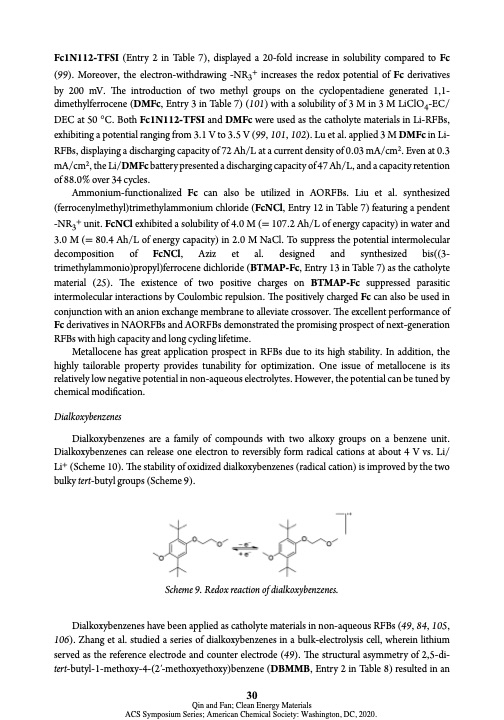
PDF Publication Title:
Text from PDF Page: 030
Fc1N112-TFSI (Entry 2 in Table 7), displayed a 20-fold increase in solubility compared to Fc (99). Moreover, the electron-withdrawing -NR3+ increases the redox potential of Fc derivatives by 200 mV. The introduction of two methyl groups on the cyclopentadiene generated 1,1- dimethylferrocene (DMFc, Entry 3 in Table 7) (101) with a solubility of 3 M in 3 M LiClO4-EC/ DEC at 50 °C. Both Fc1N112-TFSI and DMFc were used as the catholyte materials in Li-RFBs, exhibiting a potential ranging from 3.1 V to 3.5 V (99, 101, 102). Lu et al. applied 3 M DMFc in Li- RFBs, displaying a discharging capacity of 72 Ah/L at a current density of 0.03 mA/cm2. Even at 0.3 mA/cm2, the Li/DMFc battery presented a discharging capacity of 47 Ah/L, and a capacity retention of 88.0% over 34 cycles. Ammonium-functionalized Fc can also be utilized in AORFBs. Liu et al. synthesized (ferrocenylmethyl)trimethylammonium chloride (FcNCl, Entry 12 in Table 7) featuring a pendent -NR3+ unit. FcNCl exhibited a solubility of 4.0 M (= 107.2 Ah/L of energy capacity) in water and 3.0 M (= 80.4 Ah/L of energy capacity) in 2.0 M NaCl. To suppress the potential intermolecular decomposition of FcNCl, Aziz et al. designed and synthesized bis((3- trimethylammonio)propyl)ferrocene dichloride (BTMAP-Fc, Entry 13 in Table 7) as the catholyte material (25). The existence of two positive charges on BTMAP-Fc suppressed parasitic intermolecular interactions by Coulombic repulsion. The positively charged Fc can also be used in conjunction with an anion exchange membrane to alleviate crossover. The excellent performance of Fc derivatives in NAORFBs and AORFBs demonstrated the promising prospect of next-generation RFBs with high capacity and long cycling lifetime. Metallocene has great application prospect in RFBs due to its high stability. In addition, the highly tailorable property provides tunability for optimization. One issue of metallocene is its relatively low negative potential in non-aqueous electrolytes. However, the potential can be tuned by chemical modification. Dialkoxybenzenes Dialkoxybenzenes are a family of compounds with two alkoxy groups on a benzene unit. Dialkoxybenzenes can release one electron to reversibly form radical cations at about 4 V vs. Li/ Li+ (Scheme 10). The stability of oxidized dialkoxybenzenes (radical cation) is improved by the two bulky tert-butyl groups (Scheme 9). Scheme 9. Redox reaction of dialkoxybenzenes. Dialkoxybenzenes have been applied as catholyte materials in non-aqueous RFBs (49, 84, 105, 106). Zhang et al. studied a series of dialkoxybenzenes in a bulk-electrolysis cell, wherein lithium served as the reference electrode and counter electrode (49). The structural asymmetry of 2,5-di- tert-butyl-1-methoxy-4-(2′-methoxyethoxy)benzene (DBMMB, Entry 2 in Table 8) resulted in an 30 Qin and Fan; Clean Energy Materials ACS Symposium Series; American Chemical Society: Washington, DC, 2020.PDF Image | Electroactive Materials Next-Generation Redox Flow Batteries

PDF Search Title:
Electroactive Materials Next-Generation Redox Flow BatteriesOriginal File Name Searched:
bk-2020-1364.ch001.pdfDIY PDF Search: Google It | Yahoo | Bing
Salgenx Redox Flow Battery Technology: Salt water flow battery technology with low cost and great energy density that can be used for power storage and thermal storage. Let us de-risk your production using our license. Our aqueous flow battery is less cost than Tesla Megapack and available faster. Redox flow battery. No membrane needed like with Vanadium, or Bromine. Salgenx flow battery
| CONTACT TEL: 608-238-6001 Email: greg@salgenx.com | RSS | AMP |